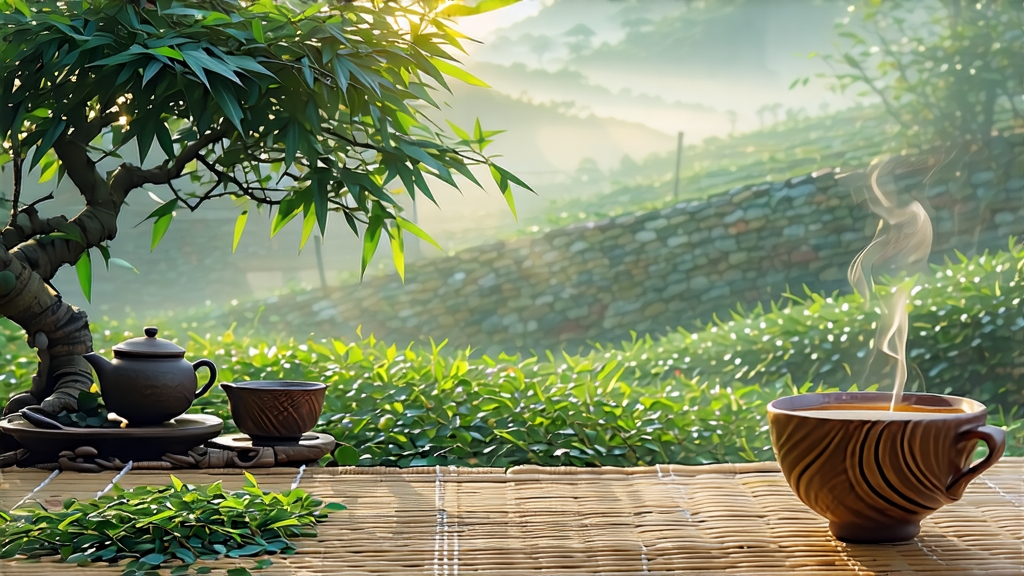
Alishan High-Mountain Oolong, known in Taiwan as “Alishan Qing Xiang Oolong,” is the island’s most celebrated gift to the global tea stage. Grown between 1,000 and 1,400 m on the ridge of Chiayi County’s mist-veiled Alishan range, this cultivar captures the cool breath of the subtropical cloud forest and distills it into a cup that tastes of orchid, alpine cream, and sun-warmed stone fruit. Its story begins in the mid-nineteenth century, when Fujianese settlers carried the soft-stemmed Qing Xin (Green Heart) tea bush across the strait together with their Mazu statues and Minnan dialect. For decades the leaf was processed into heavily roasted Dong Ding–style oolong, but during the 1980s Taiwan’s tea innovators began to lighten both oxidation and bake, allowing the pristine mountain air to speak first. Overnight Alishan became shorthand for jade-green leaves, jadeite liquor, and a fragrance so lifted it seems to levitate above the cup.
The cultivar itself is small-leaf, slow-growing, and frost-tolerant. Night temperatures on Alishan can drop to 8 °C even in May; the stress shortens the internodes, thickens the cuticle, and concentrates amino acids, especially L-theanine, which translates into a brothy umami sweetness that lingers like dew on the tongue. Because the mountain is often wrapped in fog until noon, the leaves synthesize fewer bitter catechins and more floral volatiles—geraniol, linalool, and indole—yielding an aroma that professional cuppers liken to lily, white peach, and alpine milk.
Harvest takes place by hand five times a year, yet only the spring and winter flushes are deemed worthy of the “High-Mountain” designation. Pickers climb narrow switchbacks before dawn, wearing LED headlamps and woven bamboo baskets strapped to their backs. The standard pluck is one bud plus three leaves, chosen when the third leaf is still tender enough to snap audibly. Within minutes the baskets are rushed to the on-mountain factory, a modest corrugated-iron shed perfumed with jasmine and ozone. Here the leaves undergo the most intricate choreography in all of tea manufacture: the 16-hour “high-mountain green” sequence.
First comes solar withering. The leaves are spread on bamboo trays under filtered morning light for 30–45 min, softening cell walls without bruising the edges. Next is indoor withering in a climate-controlled room kept at 22 °C and 68 % humidity. Every 15 min the tea master lifts and rattles the trays, coaxing moisture from the stems while awakening floral precursors. When the leaf loses 12 % of its weight it is ready for “yaoqing,” the critical shaking phase. Armfuls of foliage are tossed into a cylindrical bamboo drum that rotates at 8 rpm for 90 s, then rests for 30 min; the cycle repeats six times. Micro-fissures form along the veins, initiating oxidation that will halt at 18–22 %—just enough to turn the leaf rim a russet bronze while preserving the heart in jade.
Oxidation is arrested in a 260 °C tumble dryer for 3 min, flash-fixing the enzymes and locking in the signature alpine bouquet. The leaf is then balled: 12 kg batches are wrapped in cotton cloth, compressed under a 50 kg granite roller for 3 min, unwrapped, and allowed to breathe. This rolling-breathing cycle repeats 28 times over 2 h, transforming the leaf into tiny jade-green marbles streaked with mahogany. A final low-temperature bake at 80 °C for 6 h removes residual moisture and polishes the aroma; some lots receive an additional 40 °C charcoal ember bake for 2 h, adding a whisper of chestnut and smoked honey that connoisseurs call “hidden fire.”
To brew Alishan High-Mountain Oolong like a Taiwanese tea mentor, begin with a 120 ml porcelain gaiwan or a tall cylindrical aroma cup set. Use 6 g of leaf—about one heaping tablespoon—for every 100 ml of water. The water itself should be spring or filtered, drawn to 95 °C; anything hotter will scorch the delicate lactones, while cooler water leaves the tightly rolled pearls dormant. Rinse the leaf for 5 s, discarding the liquor to awaken the aromatics. The first formal infusion lasts